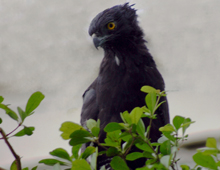Description: Black hawk-eagles are mostly black in color, but have a variety of patterns on the body and wings (white spots and bars). A white line can be seen just above each eye. The black feathers of the crest have white bases. The undertail and underwings have narrow, white bars. They have broad, short wings and a long, rounded tail. The long, narrow tail has distinctive gray bands with a brownish gray tip and is rarely fanned. The eyes are orange and the feet are yellow with black talons. Juveniles are quite different in appearance, almost the reverse of the adult coloration, being largely off-white with black streaking and mottling.
Size: Black hawk-eagles grow to 22-28 inches (56- 71 cm) in length; weigh between 2.1-2.5 pounds (0.95-1.13 kg) with the female being larger.
Behavior: Spizaetus tyrannus are solitary or in pairs. Mid morning to early afternoon high-circling flights are often accompanied with calling. Hunting for prey is mainly conducted from perches, where they briefly scan the area before taking a short flight to another branch at mid-story heights. Prey are taken by pouncing or tail-chasing. The Accipitridae family uses their senses for hunting, particularly sight, which may be up to eight times better than that of humans (also see in color). Most have excellent hearing but a poor sense of smell.
Diet: Black hawk-eagles prefer birds or arboreal mammals as their main diet (definite preference of one or the other in different areas). They will also feed on snakes and large lizards. Birds taken are larger birds such as chachalacas, toucans and
aracaris to small passerine nestlings. Small to medium- sized mammals include small monkeys squirrels, marsupials and roosting bats.
Reproduction: A stick nest, approximately 4.5 feet (1.4 m) in diameter is built in trees about 45 feet (13.7 m) from the ground. Rather than being supported by a fork of branches, the nest is supported by dense tangles of vines. The male and female perform courtship displays, including flight with contact and roll-overs. One or two eggs are laid. Fledgling (acquiring the feathers necessary for flight) takes approximately 71 days. The young have a long dependency period, therefore, permitting adults to normally nest only every third year.
Habitat/range: Spizaetus tyrannus inhabit partially forested areas, generally lowlands, although they can be found up to 6,000 feet (1,829 m). They prefer semi-open areas, second growth forests, river areas and forest ridges, but have also been found in extensive forests. They range from Mexico to Argentina and throughout Brazil.
Status: It is listed by IUCN as Least Concern (LC); CITES Appendix II.



